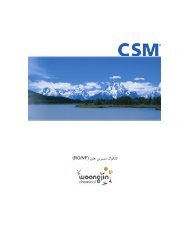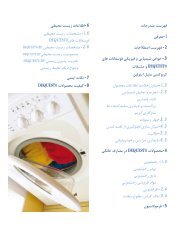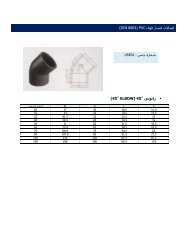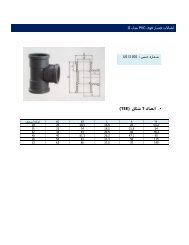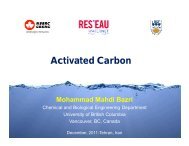What is Ozone?
What is Ozone?
What is Ozone?
You also want an ePaper? Increase the reach of your titles
YUMPU automatically turns print PDFs into web optimized ePapers that Google loves.
<strong>Ozone</strong> D<strong>is</strong>infection and<br />
Oxidation<br />
Madjid Mohseni, Ph.D., P.Eng.<br />
Professor<br />
Department of Chemical & Biological Engineering<br />
University of Brit<strong>is</strong>h Columbia<br />
Vancouver, CANADA<br />
OSMAHAB Workshop<br />
Dec. 11 & 12, 2011
<strong>What</strong> <strong>is</strong> <strong>Ozone</strong>?<br />
• Unstable form of oxygen<br />
• Produced on-site (electricity and oxygen)<br />
• Reversible reaction (2O 3 3O 2 ) - reacts with<br />
itself and with OH - in water; less stable at higher pH<br />
• It has a pungent character<strong>is</strong>tic odour<br />
• The odour <strong>is</strong> generally detectable by the<br />
human nose at concentrations between 0.02<br />
and 0.05 ppm or approx. 1/100th of the<br />
recommended 15 minute exposure level.
Toxicity of <strong>Ozone</strong> to Human<br />
<strong>Ozone</strong> concentration ppm<br />
0.1 1 10 100 1000 10000<br />
0.1 1 10 100 1000 10000<br />
Exposure time (minutes)
H<strong>is</strong>tory of <strong>Ozone</strong><br />
• 1783 - first d<strong>is</strong>covered by Van Marum<br />
• 1857 - the first electric d<strong>is</strong>charge ozone<br />
generation device was constructed by Siemens<br />
• 1893 - the first commercial application for<br />
potable water d<strong>is</strong>infection in Oudshoorn, the<br />
Netherlands<br />
• 1906, an ozone installation for water treatment<br />
process in Nice, France (th<strong>is</strong> plant represents the<br />
oldest ozonation installation in continuous<br />
operation)<br />
• 1906 - First US ozone installation at New York<br />
City’s Jerome Park Reservoir for taste and odour<br />
removal
<strong>Ozone</strong> for Water Treatment<br />
• Increased interest as an alternative to free chlorine<br />
(strong oxidant; strong microbiocidal activity; perhaps<br />
less toxic DBPs)<br />
• Very powerful oxidant (more than hypochlorous acid)<br />
• In aqueous solution <strong>is</strong> relatively unstable, having a<br />
half time of 20 to 30 min in d<strong>is</strong>tilled water at 20 ºC<br />
• <strong>Ozone</strong> cannot be stored, and must be prepared on-site<br />
• Formed by passing dry air (or oxygen) through high<br />
voltage electrodes to produce gaseous ozone that <strong>is</strong><br />
bubbled into the water to be treated
<strong>Ozone</strong> Generation Principles<br />
High Voltage<br />
Power Supply<br />
Metallic Coating<br />
O 2<br />
Glass/Ceramic Dielectric<br />
O 2<br />
Feed gas with<br />
eē- O -- O 3 O<br />
Oxygen<br />
O 2<br />
1 to 15 %wt O<br />
2<br />
e - e -<br />
3<br />
e -<br />
O O --<br />
2<br />
O 2<br />
O<br />
e - 2<br />
e - O 3 Gap (0.5 to 3.0 mm)<br />
23 to 99 %wt O 2<br />
Stainless Steel<br />
Cooling Water<br />
Ground Electrode
<strong>Ozone</strong> Production Efficiency<br />
1. UV Lamp<br />
– Ave. ozone<br />
– production/ UV lamp - 0.1 wt%<br />
2. Corona D<strong>is</strong>charge<br />
– Ave. <strong>Ozone</strong> production<br />
– 0 - 10 wt%<br />
Energy Consumption<br />
– 20 kWh/kg O 3 with air<br />
– 10 kWh/kg O 3 with O 2
<strong>Ozone</strong> Application Points<br />
(within water treatment train)<br />
Pre-<br />
Ozonation<br />
O 3<br />
Intermediate<br />
Ozonation<br />
Post-<br />
Ozonation<br />
O 3<br />
O 3<br />
Secondary<br />
D<strong>is</strong>infectant<br />
Raw<br />
Water<br />
Supply<br />
Coagulation/<br />
Flocculation<br />
Sedimentation<br />
Filtration<br />
D<strong>is</strong>infection<br />
D<strong>is</strong>tribution<br />
System
<strong>What</strong> <strong>is</strong> it Used For?<br />
• Chemical oxidation (one of strongest oxidants)<br />
• DBP Control<br />
• Organics Oxidation<br />
• D<strong>is</strong>infection<br />
• Micro-flocculation<br />
• Taste and Odor Control<br />
• Iron and Manganese Oxidation<br />
• Hydrogen Sulfide Oxidation<br />
• Colour removal
<strong>What</strong> <strong>is</strong> it Used For?<br />
• Chemical oxidation (one of strongest oxidants)<br />
• DBP Control<br />
• Organics Oxidation<br />
• D<strong>is</strong>infection<br />
• Micro-flocculation<br />
• Taste and Odor Control<br />
• Iron and Manganese Oxidation<br />
• Hydrogen Sulfide Oxidation
D<strong>is</strong>infection Activity and the CT Concept<br />
• D<strong>is</strong>infection activity can be expressed as the product of<br />
d<strong>is</strong>infectant concentration (C) and contact time (t)<br />
• Assumes first order kinetics (Chick’s Law) such that d<strong>is</strong>infectant<br />
concentration and contact time have the same “weight” or<br />
contribution in d<strong>is</strong>infection activity and in contributing to CT<br />
• Example: If C.t = 100 mg/l-minutes, then<br />
• If C = 10 mg/l, T must = 10 min. in order to get C.t = 100 mg/l-min.<br />
• If C = 1 mg/l, then T must = 100 min. to get C.t = 100 mg/l-min.<br />
• So, any combination of C and t giving a product of 100 <strong>is</strong><br />
acceptable because C and t are interchangeable<br />
• The C.t concept fails if d<strong>is</strong>infection kinetics do not<br />
follow Chick’s Law (are not first-order or exponential)
CT for Giardia Inactivation Credit<br />
3.5<br />
3<br />
0.5 log<br />
1.0 log<br />
1.5 log<br />
CT (mg*min/L)<br />
2.5<br />
2<br />
1.5<br />
1<br />
2.0 log<br />
2.5 log<br />
3.0 log<br />
0.5<br />
0<br />
0 5 10 15 20 25 30<br />
Temperature (C)
<strong>Ozone</strong> D<strong>is</strong>infection Power<br />
CT for 3-log Giardia cyst inactivation @ 10 o C and pH 7
Advantages<br />
<br />
<br />
<br />
<br />
<strong>Ozone</strong> D<strong>is</strong>infection<br />
(advantages and d<strong>is</strong>advantages)<br />
Adequate d<strong>is</strong>infection<br />
Reduction of chlorine or chloramine dosage<br />
Reduction of some DBPs: THMs, HAAs, and HANs<br />
Very small THM formation when applied with chloramine<br />
D<strong>is</strong>advantages<br />
Reduction with bromide ion resulting in brominated DBPs<br />
Increase in biodegradable organic matter<br />
No residual d<strong>is</strong>infectant
<strong>Ozone</strong> vs. UV and Membrane<br />
• Membrane integrity and cleaning <strong>is</strong> an important factor,<br />
depending on raw water quality<br />
• Taste and odour problems can not be resolved with UV or<br />
membrane applications<br />
• Micropollutants cannot be removed by UV or membranes.<br />
data indicates that ozone has an improved capability to<br />
remove these compounds<br />
• Algae toxins are not affected by membrane or UV<br />
applications<br />
• <strong>Ozone</strong> <strong>is</strong> known for its ability to remove algae toxins
<strong>What</strong> <strong>is</strong> it Used For?<br />
• Chemical oxidation (one of strongest oxidants)<br />
• DBP Control<br />
• Organics Oxidation<br />
• D<strong>is</strong>infection<br />
• Micro-flocculation<br />
• Taste and Odor Control<br />
• Iron and Manganese Oxidation<br />
• Hydrogen Sulfide Oxidation
Ozonation of water<br />
• <strong>Ozone</strong> reacts with substances in two different ways<br />
• direct<br />
• indirect<br />
• These different reaction pathways lead to different<br />
oxidation products and are controlled by different<br />
types of kinetics<br />
Direct reaction:<br />
• Th<strong>is</strong> <strong>is</strong> a selective reaction with relatively slow reaction rate<br />
constant (e.g. k=1.0-10 3 M -1 s -1 )<br />
• The ozone molecule reacts with the unsaturated bond due to<br />
its dipolar structure and leads to a splitting of the bond
Degree of removal of trace organics<br />
(full scale water treatment)<br />
substance Removal (%)<br />
Taste & odor 20-90<br />
Alkanes
Indirect Reaction Pathway<br />
OH _<br />
O 2<br />
K= 10 6 -10 9 M -1 s -1<br />
O<br />
• _ K= 70-140 M -1 s -1<br />
2<br />
O<br />
• _ HO<br />
•<br />
3 2<br />
OH •<br />
O 3<br />
O 3<br />
O 2<br />
HO 3<br />
•<br />
HO 4<br />
•<br />
O 2
Factors Affecting Ozonation Reactor<br />
• <strong>Ozone</strong> concentration<br />
• The equilibrium O 3 conc. in water, all other things being equal, will<br />
vary with the ozone conc. in the feed gas<br />
• Bubble size<br />
• Smaller bubbles have a larger surface area per unit volume<br />
• Pressure<br />
• The gas transfer rate <strong>is</strong> dependent on pressure<br />
• The ozone demand of water<br />
• Presence of reduced Fe and Mn speeds up the removal of ozone<br />
• pH<br />
• At elevated pH values ozone decays rapidly
How Much <strong>Ozone</strong> <strong>is</strong> Needed?<br />
• Based on:<br />
– Pilot Plant Studies<br />
– Previous Experience<br />
– Extrapolated Models<br />
• Typical Dosages:<br />
– D<strong>is</strong>infection 1-3 mg/L<br />
– Chemical Oxidation<br />
4-6 mg O 3 /mg S<br />
1.0 mg O 3 /mg NO 2<br />
0.9 mg O 3 /mg Mn<br />
0.4 mg O 3 /mg Fe
How Long Does it React?<br />
• Reactors (Contactors)<br />
are multi-celled<br />
chambers or pipelines<br />
• Range from 4 minutes<br />
up to 40 minutes<br />
• Longer contact times for<br />
cold water d<strong>is</strong>infection
Design Considerations<br />
1. Selection of a feed gas system<br />
2. Preparation of the feed gas system<br />
3. Selection of the ozone generator<br />
4. Design of the ozone contact basin<br />
5. Destruction of off-gas ozone.
Feed Gas Selection<br />
<strong>Ozone</strong> may be generated from air, oxygen- enriched<br />
air, or oxygen.<br />
Concentration of ozone:<br />
- Air: 1.5~5% by weight<br />
- High-purity oxygen: 8~14% by the same generator<br />
Both air and pure oxygen must be treated prior to<br />
being fed to the ozone generator to maximize the<br />
ozone production and to minimize maintenance work<br />
on the ozonator.<br />
Oxygen: stored as a liquid (LOX) or generated on-site<br />
through either a cryogenic process with vacuum<br />
swing adsorption (VSA) or with pressure swing<br />
adsorption (PSA).
Air vs. High Purity Gas Oxygen Feed<br />
Source Advantages D<strong>is</strong>advantages<br />
Air Commonly used equipment More energy consumed per ozone<br />
Proven technology<br />
volume produced<br />
Suitable for small and large systems Extensive gas handling equipment<br />
required<br />
Max. ozone conc. of 3~5%<br />
Oxygen Higher ozone conc. (8~14%) Safety concerns<br />
(general) Approximately doubles ozone Oxygen res<strong>is</strong>tant materials required<br />
conc. for same generator<br />
Suitable for small and large systems<br />
LOX Less equipment required Variable LOX costs<br />
Simple to operate and maintain Storage of oxygen on site (fire<br />
Suitable for small and intermediate codes, i.e., safety concerns)<br />
systems<br />
Loss of LOX in storage when not<br />
Can store excess oxygen to meet in use<br />
peak demands<br />
Cryogenic Equipment similar to air preparation More complex than LOX<br />
systems<br />
Extensive gas handling equipment<br />
Feasible for large systems<br />
required<br />
Can store excess oxygen to meet Capital intensive<br />
peak demands<br />
Complex systems to operate and<br />
maintain
Feed Gas Treatment<br />
• Dust- reduces the efficiency of ozone production<br />
• Oil - fouls the dielectric<br />
• Nitrogen gas - produces nitric acid<br />
• Mo<strong>is</strong>ture - reduces the life span of the dielectric of the<br />
ozone generator and increases the power requirement<br />
Generally composed of a precompressor with a 5 µm<br />
paper filter, main compressor, after cooler, oil<br />
coalescer, refrigerant dryer (optional), heat<br />
reactivated desiccant dryer with activated alumina<br />
and molecular sieves or silica gel, 1 µm filter,<br />
hygrometer, gas flow meter, and pressure- regulating<br />
valve.
<strong>Ozone</strong> Generation<br />
Generated by passing a high voltage alternating current<br />
(6 ~ 20 kV) across a dielectric d<strong>is</strong>charge gap through<br />
which oxygen-bearing gas <strong>is</strong> injected.<br />
1. Low-frequency (50 ~ 60 Hz) units with variable<br />
voltage (10 ~ 20 kV) (single phase power);<br />
2.Medium-frequency (200 ~ 1000 Hz) units with<br />
constant voltage, variable voltage, or frequency<br />
control (8 ~ 10 kV) (three phase power);<br />
3. High-frequency (600 ~ 2000 Hz) units (8 ~ 10<br />
kV) (three phase power).
Character<strong>is</strong>tic<br />
<strong>Ozone</strong> Generation<br />
Low<br />
(50 ~ 60 Hz)<br />
Medium<br />
(up to 1,000 Hz)<br />
High<br />
(> 1,000 Hz)<br />
Degree of electronics<br />
soph<strong>is</strong>tication<br />
Low High High<br />
Peak voltages 19.5 11.5 10<br />
Turndown ratio 5:1 10:1 10:1<br />
Cooling water required<br />
(gal/lb of ozone produced)<br />
0.5 ~ 1.0 0.5 ~ 1.5 0.25 ~ 1<br />
Typical application range < 500 lb/day to 2,000 lb/day to 2,000 lb/day<br />
Operating concentrations<br />
wt - % in air<br />
0.5 ~ 1.5% 1.0 ~ 2.5% +<br />
1.0 ~ 2.5% +<br />
wt - % in oxygen 2.0 ~ 5.0% 2 ~ 12% 2 ~ 12%<br />
Optimum ozone production<br />
(as a proportion of total<br />
generator capacity)<br />
Optimum cooling water<br />
differential<br />
Power required<br />
(kW-h/lb O3)<br />
Air feed system power<br />
requirements (kW-h/lb O3)<br />
60 ~ 75% 90 ~ 95% 90 ~ 95%<br />
8 ~ 10F 5 ~ 8F 5 ~ 8F<br />
Air feed: 8 ~ 12<br />
O2 feed: 4 ~ 6<br />
Air feed: 8 ~ 12<br />
O2 feed: 4 ~ 6<br />
Air feed: 8 ~ 12<br />
O2 feed: 4 ~ 6<br />
5 ~ 7 5 ~ 7 5 ~ 7<br />
Source: Adapted from Rice (1996) with modifications.
<strong>Ozone</strong> Generator & Contactors
<strong>Ozone</strong> Generators
<strong>Ozone</strong> Contact Tank<br />
<strong>Ozone</strong> solubility: low<br />
20°C: 6.43 and 12.86 mg/L for ozone conc. of 18.11<br />
and 36.21 mg/L. Thus, effective mixing <strong>is</strong> critical.<br />
o Diffused bubbles (con- and counter-current);<br />
o Positive pressure injection (U-tube);<br />
o Negative pressure (Venturi tube);<br />
o Turbine mixer tank;<br />
o Packed tower; and<br />
o In-line<br />
Completely closed; composed of concrete, located<br />
outside, two cells in each tank, capable of handling<br />
50% of the max. daily flow.
Conventional Contactor Design<br />
OZONE ANALYZER #1<br />
CELLS 1 - 2<br />
OZONE ANALYZER #2<br />
CELLS 4 - 5 - 6<br />
OZONE ANALYZER #3<br />
CELLS 8 - 10 - 12<br />
E<br />
OZONE ANALYZER<br />
EFFLUENT FLUME<br />
2 4<br />
6<br />
8 10 12<br />
1<br />
5<br />
E<br />
INFLUENT<br />
EFFLUENT<br />
OZONE GAS FROM<br />
E<br />
GENERATORS<br />
Measure “Conc.” at several points in the contactor
<strong>Ozone</strong> Bubble Contactor<br />
Counter Current Contactor<br />
Counter and Cocurrent Contactor<br />
Influent<br />
Influent<br />
<strong>Ozone</strong> Gas<br />
<strong>Ozone</strong> Gas<br />
Cocurrent Contactor<br />
Influent<br />
<strong>Ozone</strong> Gas
<strong>Ozone</strong> Diffuser<br />
7” Ceramic Dome<br />
Diffusers
<strong>Ozone</strong> Contactor Diffusers
<strong>Ozone</strong> Contactor Diffusers
Bubble Diffuser Contactor<br />
(advantages & d<strong>is</strong>advantages)<br />
Advantages<br />
• No moving parts<br />
• Effective ozone transfer<br />
• Low hydraulic headloss<br />
• Operational simplicity<br />
D<strong>is</strong>advantages<br />
• Deep contact basins<br />
• Vertical channeling of bubbles<br />
• Maintenance of gaskets and piping
Side Stream <strong>Ozone</strong> Injection System<br />
A. In-line Injector System<br />
<strong>Ozone</strong> Gas<br />
Off Gas<br />
Influent<br />
Contactor<br />
Injector<br />
B. Sidestream Injector System<br />
<strong>Ozone</strong> Gas<br />
Injector<br />
Off Gas<br />
Influent<br />
Static<br />
Mixer<br />
Contactor
Side Stream <strong>Ozone</strong> Injection
Injection Contacting<br />
(advantages and d<strong>is</strong>advantages)<br />
Advantages<br />
• Injection and static mixing have no moving parts<br />
• Very effective ozone transfer<br />
• Contactor depth less than bubble diffusion<br />
D<strong>is</strong>advantages<br />
• Additional headloss (energy usage) due to static<br />
mixers which may require pumping<br />
• Turndown capability limited by injection system<br />
• More complex operation and high cost
Turbine Mixer <strong>Ozone</strong> Contactor
Turbine Mixer <strong>Ozone</strong> Contactor<br />
(advantages and d<strong>is</strong>advantages)<br />
Advantages<br />
• <strong>Ozone</strong> transfer <strong>is</strong> enhanced by high turbulence resulting in<br />
small bubble size<br />
• Contactor depth less than bubble diffusion<br />
• Aspirating turbines can draw off-gas from other chambers<br />
for reuse<br />
• Eliminates diffuser clogging concerns<br />
D<strong>is</strong>advantages<br />
• Require energy input<br />
• Constant gas flow rate should be maintained, reducing<br />
ozone transfer efficiency<br />
• Maintenance requirements for turbine and motor
Off-Gas Destruction<br />
<strong>Ozone</strong> transfer efficiency: 90 ~ 95%.<br />
o Hence, 5 ~ 10% goes to off-gas (500 ppm by volume).<br />
o Must be reduced to levels below the OSHA (< 0.0002 g/m<br />
for 8 hr working day) and local Air Quality Management<br />
D<strong>is</strong>trict (AQMD) standards.<br />
1. Thermal destruction (570 ~ 660°F) for the air<br />
feed gas system<br />
2. Thermal destruction with catalyst (85 ~ 120°F)<br />
for the oxygen feed gas system<br />
3. Catalytic destruction: metal (platinum or palladium),<br />
metal oxides (aluminum oxide or manganese oxide),<br />
or hydroxides and peroxides. Lower operating cost
Other Design Criteria<br />
• <strong>Ozone</strong> dosage<br />
• # of ozone<br />
generator<br />
1.5~3 mg/L (normal)<br />
Min. two, preferably three, one<br />
always as standby<br />
<strong>Ozone</strong> generator<br />
• Min. production 10~20% of rated capacity<br />
• Max. production 75% of rated capacity<br />
• Cooling water temp. < 24°C at the inlet<br />
• Vessel construction Pressure vessel (15 psig) constructed<br />
with 304 SS or 316 SS with Teflon gaskets<br />
<strong>Ozone</strong> contact tanks<br />
• Number of tanks Min. two<br />
• Transfer efficiency Min. 95% if possible (90~95%)<br />
• Retention time 5~15 min. (usually < 8 min)<br />
• Water depth 18~20 ft<br />
• Diffuser depth 16~18 ft
Representative WTP <strong>Ozone</strong><br />
System Costs
Representative WTP <strong>Ozone</strong><br />
System Costs
Cost Factors<br />
Factors influencing Capital Cost<br />
• Process (dose, contacting)<br />
• Feed Gas<br />
• Injection/Contacting<br />
Factors influencing O&M Costs<br />
• Local power and LOX costs<br />
• Process Control
• Hospitality<br />
<strong>Ozone</strong> Applications<br />
in other industries<br />
• Gaming halls, casinos, bowling venues<br />
• Food processing and storage<br />
• Fruits and vegetables cleanings and storage<br />
• Fresh meat, f<strong>is</strong>h and poultry washing<br />
• Farming applications<br />
• F<strong>is</strong>h and poultry farms<br />
• Horticulture<br />
• Nurseries, cut flower storage, mushroom growing<br />
• Retail and workplace<br />
• Office space, business centres, restaurants
<strong>Ozone</strong> Applications<br />
in Hospitality Industry<br />
• <strong>Ozone</strong> has been applied in large scale in HVAC<br />
systems of many hospitality businesses and public<br />
areas<br />
‣ Increased IAQ problems due to sealed buildings and less<br />
makeup (outside) air metered into HVAC systems.<br />
‣ Increased public intolerance for smoking and the realization<br />
that many common chemicals contribute to poor IAQ.<br />
‣ Attractive payback economics due to savings in energy and in<br />
replen<strong>is</strong>hments for carbon filters (which are otherw<strong>is</strong>e used)<br />
‣ New ozone generator and ozone monitor designs.
<strong>Ozone</strong> Applications<br />
in Hospitality Industry<br />
• Case of Bingo Hall in Washington State<br />
‣ ~ 2000 m 2 total area (with ~800 m 2 smoking area)<br />
‣ complaints from players and employees in the smoking<br />
section about strong odors and physical d<strong>is</strong>comfort associated<br />
with exposure to excessive levels of tobacco smoke, VOCs –<br />
burning and itchy eyes, dry throat, headaches, nausea<br />
‣ Two 3,500 cfm exhaust fans were added to the smoking<br />
section to evacuate the smoke<br />
‣ The energy cost of exhausting 7,000 cfm of conditioned air<br />
ran in excess of $350 per month and caused the internal<br />
temperature to fluctuate beyond acceptable norms during<br />
extremes of temperature.
<strong>Ozone</strong> Applications<br />
in Hospitality Industry<br />
• Case of Bingo Hall in Washington State<br />
Two options of Activated Carbon and <strong>Ozone</strong><br />
were considered<br />
‣ Activated Carbon was estimated to cost about $25,000 per<br />
year (cost of replen<strong>is</strong>hment of expended carbon)<br />
‣ With four 10 grams per hour ozone generators, the installed<br />
price of ozone was around $22,000 plus small O&M expenses<br />
for quarterly cleanings and annual monitor calibration.<br />
In addition, energy savings of more than $250 per month due to<br />
reduced demand for outside air and reduced operation of the<br />
7,000 cfm exhaust system.
Challenges with the Use of <strong>Ozone</strong><br />
in public areas<br />
• <strong>Ozone</strong> concentration in public areas must be<br />
kept below harmful levels<br />
• Safe concentrations generally are considered<br />
in the range 0.05-0.10 ppm<br />
• Most HVAC systems are programmed not to exceed 0.03-<br />
0.05 ppm<br />
o O 3 concentrations are higher in the supply ducts, where the<br />
ozone generators feed in (typically 0.3-0.5 ppm).<br />
o Bacteria, mold, mildew, and VOCs are greatly reduced in those<br />
ducts, and thus eventually in the entire HVAC system (O 3 drops<br />
in concentration by a factor of 10 or so due to these reactions as<br />
well as due to normal "half life" reversion back to oxygen
<strong>Ozone</strong> Applications<br />
in Food Processing<br />
• Case of fruit and vegetable cleaning and washing<br />
‣ <strong>Ozone</strong> d<strong>is</strong>solved in water for washing and d<strong>is</strong>infecting<br />
can dramatically reduce losses from spoiled produce<br />
‣ When compared to the traditional use of chlorine it<br />
offers d<strong>is</strong>tinct advantages.<br />
• The level of ozone in the rinse water can be conveniently and<br />
accurately controlled.<br />
• <strong>Ozone</strong> <strong>is</strong> not pH dependant.<br />
• <strong>Ozone</strong> does not cause the weight loss in fruit that chlorine<br />
does.<br />
• <strong>Ozone</strong> leaves no residue to taint the product.<br />
• It <strong>is</strong> produced as required and therefore needs no storage.
<strong>Ozone</strong> Applications<br />
in Fresh Meat, F<strong>is</strong>h & Poultry<br />
‣ <strong>Ozone</strong> d<strong>is</strong>solved in water as a wash or spray can be<br />
used in food processing as a potent d<strong>is</strong>infectant (to<br />
kill bacteria, viruses, parasites and fungi).<br />
• In 1997 ozone gained the FDA approval of GRAS<br />
(Generally Recogn<strong>is</strong>ed As Safe) and later in 2001 was<br />
allowed as a direct food additive in contact with food<br />
including meat and poultry<br />
‣ Gaseous ozone in storage or even processing<br />
environments can provide an effective treatment<br />
against airborne and surface contamination.
<strong>What</strong> Have I told You?<br />
• Applications of ozone in d<strong>is</strong>infection and<br />
oxidation<br />
• Water treatment<br />
• Taste and odour control<br />
• Air treatment<br />
• Food processing
<strong>What</strong> to Watch For?<br />
The Design and Implementation of OZONE<br />
requires technical knowledge<br />
• Design phase <strong>is</strong> very important and proper design <strong>is</strong><br />
essential<br />
• Control approaches vary for different applications<br />
• Optimized dosage and tracking of systems performance<br />
should be considered<br />
• Be aware of safety <strong>is</strong>sues<br />
• Good Design + Trained and Aware Staff = Safe,<br />
efficient and sometimes low cost ozone system
Thank You !<br />
Madjid Mohseni, Ph.D., P.Eng.<br />
Department of Chemical & Biological Engineering<br />
University of Brit<strong>is</strong>h Columbia<br />
Phone: +1(604)822-0047<br />
E-mail: mmohseni@chbe.ubc.ca



